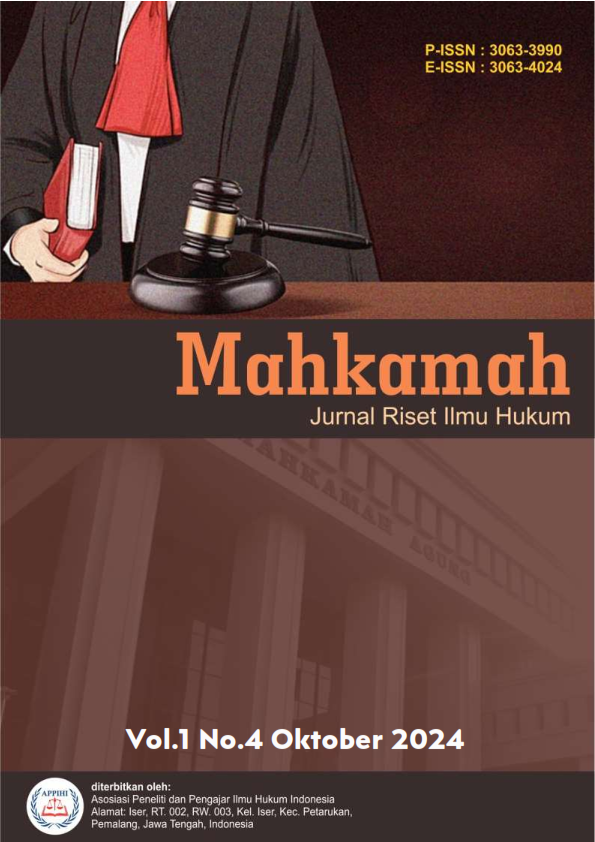Analisis Yuridis Mengenai Tindak Pidana Pembunuhan Menghilangkan Nyawa Seseorang
Studi Kasus Nomor 200/Pid.B/2023/PN KBJ
DOI:
https://doi.org/10.62383/mahkamah.v1i4.165Keywords:
Crime, Murder, Taking Someone's LifeAbstract
In Article 338 of the Criminal Code, the element of taking a life is formulated as een ander van het leven beroven which means "taking another person's life". Because the act or behavior of taking another person's life does not always contain an element of violence, whereas if the word oven is translated with the word plunder then the act must be carried out with violence. The research method used in this thesis is juridical-empirical. Juridical-empirical research is legal research regarding the application or implementation of normative legal provisions directly to each specific legal event that occurs in society. Data collection methods are techniques or methods that can be used by researchers to collect data. The technique of designating a word that is abstract and not manifested in objects, but its use can only be seen through: questionnaires, interviews, observations, exams (tests), documentation, etc. Based on the research results, in case 200/Pid.B/2023/PN Kabanjahe, the application of Article 338 of the Criminal Code (KUHP) as a basis for assessing the crime of murder has a number of aspects that need to be studied in depth. The Public Prosecutor charged the Defendant with many articles, starting from Article 170 paragraph (2) 3e of the Criminal Code to Article 55 paragraph (1) 1st of the Criminal Code. This shows the prosecutor's efforts to cover all actions carried out by the Defendant. However, the main focus should be on premeditated murder, which is regulated in Article 340 of the Criminal Code. In case 200/Pid.B/2023/PN Kabanjahe, the defendant Melina Simanjuntak alias Mamak Rani alias Ina Juntak was found guilty of committing the crime of murder accompanied by theft based on Article 339 of the Criminal Code in conjunction with Article 55 paragraph (1) 1st of the Criminal Code. The Panel of Judges considered a number of legal facts revealed during the trial, including the Defendant's direct involvement in the criminal acts committed with Jamando Sipayung. The use of strong evidence, such as bloodstains and valuables belonging to the victim, further strengthens the charges. Therefore, the Defendant was sentenced to prison for 15 years, with the period of detention already served being deducted from the sentence. Based on the research that has been carried out, it can be concluded that in case 200/Pid.B/2023/PN Kbj, the application of the elements The crime of murder as regulated in Article 338 of the Criminal Code has been carried out carefully. Apart from that, the consideration of the Panel of Judges in handing down sentences against perpetrators also reflects justice. The judge considers the background of the case, the perpetrator's motivation based on hurt feelings, and the impact of the act on the victim and his family
Downloads
References
Ali, A., & Achmad, Z. (2002). Keterpurukan hukum di Indonesia. Jakarta: Ghalia Indonesia.
Ali, Z. (2009). Hukum pidana Islam. Jakarta: Sinar Grafika Offset.
Atmasasmita, R. (2000). Perbandingan hukum pidana. Bandung: Mandar Maju.
Badan Pusat Statistik. (n.d.). Jumlah kasus kejahatan pembunuhan pada satu tahun terakhir. Retrieved from https://www.bps.go.id/id/statistics-table/2/MTMwNiMy/jumlah-kasus-kejahatan-pembunuhan-pada-satu-tahun-terakhir--kasus-.html
Farid, Z. A. (2007). Hukum pidana 1. Jakarta: Sinar Grafika.
Fikri. (2013). Analisis yuridis terhadap delik penganiayaan berencana. Jurnal Ilmu Hukum Legal Opinion, 1(2).
Friedman, L. M. (2011). Sistem hukum perspektif ilmu sosial. Bandung: Nusa Media.
Fuady, M. (2003). Aliran hukum kritis paradigma ketidakberdayaan hukum. Bandung: PT. Citra Aditya Bakti.
Gunadi, I., & Efendi, J. (2014). Cepat dan mudah memahami hukum pidana (Edisi pertama). Jakarta: PT. Fajar Interratama Mandiri.
Harahap, Y. (2010). Pembahasan permasalahan dan penerapan KUHAP. Jakarta: Sinar Grafika.
Irfan, N., & Masyrofah. (2016). Fiqh jinayah. Jakarta: Amzah.
Kitab Undang-Undang Hukum Pidana (KUHP).
Konsep KUHP 1991/1992.
Lamintang, P. A. F. (1997). Dasar-dasar hukum pidana Indonesia. Bandung: Citra Aditya.
Mahkamah Agung. (n.d.). Retrieved from https://putusan3.mahkamahagung.go.id/direktori/index/pengadilan/pn-kabanjahe/kategori/pidana-umum-1.html
Marlina. (2009). Peradilan pidana anak di Indonesia. Bandung: Refika Aditama.
Marpaung, L. (2002). Tindak pidana terhadap nyawa dan tubuh (pemberantas dan prevensinya). Jakarta: Sinar Grafika.
Prasetyo, T. (2010). Hukum pidana. Depok: Raja Grafindo Persada.
Prodjodikoro, W. (1989). Asas-asas hukum pidana di Indonesia. Bandung: Eresco.
Raharjo, M. F. S. (2016). Teori-teori hukum klasik dan kontemporer. Jakarta: Ghalia Indonesia.
Rahman, A. I. (1992). Tindak pidana dalam syariat Islam. Jakarta: Rineka Cipta.
Renggong, R. (2016). Hukum pidana khusus: Memahami delik-delik di luar KUHP. Jakarta: PT Kharisma Putra Utama.
Santoso, T. (2001). Menggagas hukum pidana Islam. Bandung: Asy Syaamil Press & Grafika.
Simamora, S., Dongan, & Hertini, M. F. (2015). Hukum pidana dalam bagan. Pontianak: Fhuntan Press.
Tompodung, H. R. R., Sondakh, M. T., & Rimbing, N. (2021). Kajian yuridis tindak pidana penganiayaan yang mengakibatkan kematian. Jurnal Lex Crimen, 10(4).
Undang-Undang Dasar Negara Republik Indonesia Tahun 1945.
Undang-Undang No. 1 Tahun 2023 KUHP Baru, Pasal 100.
Undang-Undang No. 1 Tahun 2023 KUHP Baru, Pasal 459.
Downloads
Published
How to Cite
Issue
Section
License
Copyright (c) 2024 Mahkamah : Jurnal Riset Ilmu Hukum

This work is licensed under a Creative Commons Attribution-ShareAlike 4.0 International License.






